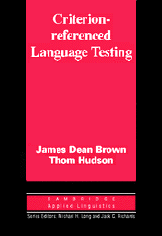
Shiken: JALT Testing & Evaluation SIG Newsletter Vol. 7. No. 3. Autumn 2003. (p. 8 - 11) [ISSN 1881-5537]

 PDF Version
PDF Version

Book Review
Criterion-referenced Language Testing (Cambridge Applied Linguistics Series).
by J. D. Brown & Thom Hudson (2002)
Cambridge, UK / New York: Cambridge University Press (311 pages)
Chapter 1. Alternative paradigms
[ p. 8 ]
Chapter 2. Curriculum-related testing
Chapter 3. Criteria-reference test items
| "classroom teachers interested in grounding their testing practices more deeply in theory will find this work worthwhile." |
Chapter 4. Basic descriptive and item statistics for CRTs
[ p. 9 ]
Chapter 5. Reliability, Dependability, and Unidimensionality
Chapter 6. Validity of CRTs
Chapter 7. Administering, giving feedback, and reporting on CRTs
[ p. 10 ]